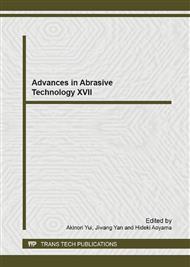p.114
p.120
p.129
p.135
p.141
p.147
p.154
p.160
p.166
Feature Extraction Based 3D Model Registration for Surface Finish Quality Evaluation
Abstract:
Engineers and designers constantly strive to design machines that have high life cycle, can run faster, and can manufacture products having higher geometrical accuracy. However, manufacturing processes often produce parts with surfaces that are unsatisfactory from the viewpoint of geometrical precision or quality of surface texture. In general, electronic, optical, and tactual methods are used for exploring and evaluating the surface texture and the surface geometry. With the advancements in the reverse engineering technology, computer based numerical analysis of the data obtained from 3D imaging devices, referred to as registration, has also emerged as a tool for shape inspection. Registration expedites shape inspection by augmenting the process of error measurement. The existing registration methods suffer from problems that limit the extensive use of the existing approaches, thereby making them application specific. In this research, we propose a novel approach for reducing the number of data points used for registration without compromising with registration accuracy. We propose a segmentation based registration approach that utilizes the features extracted from the models, thus reducing the data size. The registered data sets can be compared to each other for evaluating the differences in shape. The difference information can further be used to appropriately modify the manufacturing process parameters for obtaining highly accurate products.
Info:
Periodical:
Pages:
141-146
Citation:
Online since:
September 2014
Authors:
Price:
Сopyright:
© 2014 Trans Tech Publications Ltd. All Rights Reserved
Share:
Citation:


